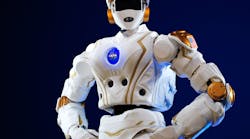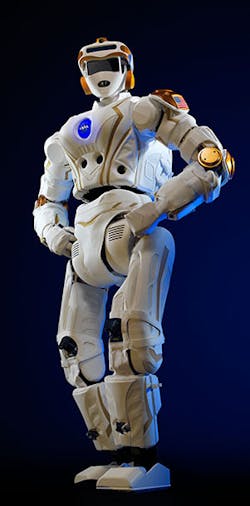The National Aeronautics and Space Administration (NASA) is making two prototypes of its humanoid Valkyrie robot available to United States universities “for active research of high-level humanoid behaviors.” The agency recently announced that it would give one prototype to a research laboratory at the Massachusetts Institute of Technology (MIT), and the other to researchers at Northeastern University.
Officially designated as the R5 model—but known more colloquially as the “superhero robot”—the Valkyrie was built in 2013 to compete in the DARPA Robotics Challenge, an annual competition that tests humanoid robots in a series of disaster-relief scenarios. The robot was originally designed by a research team from NASA’s Johnson Space Center in Houston, in partnership with the University of Texas and Texas A&M.
The administration will lend one Valkyrie prototype to each university, providing technical support from NASA engineers and up to $250,000 in funding for each of the next two years. Both projects are focused on developing new software programs that can make the Valkyrie robots more autonomous and resilient when carrying out tasks during space missions.
NASA is hoping that humanoid robotics will eventually be able to assist or take the place of astronauts working in extreme environments. For instance, the administration has expressed interest in sending robots to Mars before humans so that they can prepare for human astronauts arriving on the planet. The robots could also assist the astronauts with routine maintenance and other repairs during the mission.
The MIT project, led by Russ Tedrake, the Director of the Center for Robotics at MIT’s Computer Science and Artificial Intelligence Lab, has been titled “Robust Autonomy for Extreme Space Environments.” The Northeastern project, headed by Professor Tashkin Padir, is called “Accessible Testing on Humanoid-Robot-R5 and Evaluation of NASA Administered (ATHENA) Space Robotics Challenge," referring to the competition where both research teams will reveal their upgrades to NASA.
The problem of interacting with an unpredictable and complex environment is one of the primary concerns with the MIT project, said Tedrake in a statement to IEEE Spectrum. His personal goal over the next two years is enabling the Valkyrie robot to more efficiently interact with the environment without a safety harness or belay. This problem, he notes, will require careful revisions to the entire sensor system and control stack.
Realistic interactions with the environment were one of the rarest sights at the DARPA Robotics Challenge earlier this year, an event that serves as barometer for the state of humanoid robotics. Unintentional contact with the environment usually caused the robot to fall, especially if it could not turn a valve, cut into a wall, or toggle a switch with extreme precision.
The ability of humanoid robots to roll with the punches of an unstructured environment has been at the heart of recent research. Earlier this year, Boston Dynamics released video footage of its experiments with the Atlas humanoid robot. It showed the robot walking across rocky terrain and recovering its balance after being hit with a weight.
On the cognitive side of the spectrum, DARPA is funding research to forge more intuitive interactions between humans and computers. For instance, Colorado State University researchers are developing new technologies for making computers recognize not only verbal instructions but also non-verbal ones. The research has the potential not only to make robots more collaborative with humans but also more intuitive when reacting to their environment.
Meanwhile, the research team from Northeastern has revealed little about the technological aims of their project. Padir, an associate professor of electrical and computer engineering, discussed the project on his personal blog, saying that it would concentrate on “novel perception-based grasping and human-robot interaction techniques.”
Padir, who led the robotics program at Worcester Polytechnic Institute before transferring to Northeastern, also wrote that the research team would combine a wide range of expertise. Joining him on the research project is Robert Platt, an assistant professor of computer and information science, who worked on the grasping and manipulation technology used in NASA's Robonaut 2 robotic torso. Also involved with the research is Holly Yanco, professor of computer science at the University of Massachusetts, Lowell, who studies human-computer interactions and the visualization of sensor data.
The other focus that Padir has for the research is fostering progress in the field of autonomous robotics. He also wants to make the Valkyrie software developed in the research project available to the entire humanoid robotics community.
“Successful completion of this project will not only progress the technological readiness of humanoid robots for practical applications,” he writes, “but also nurture a community of competitors and collaborators."
Correction: December 10, 2015
An earlier version of this article misstated one of the universities that received an R5 prototype. It was Northeastern University, not Northwestern.

